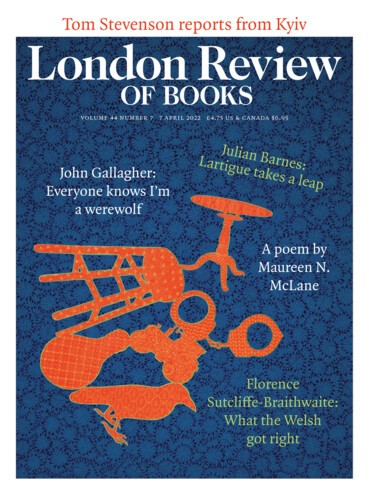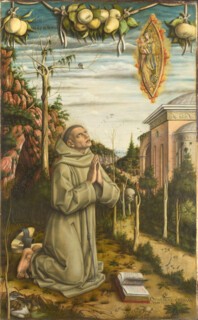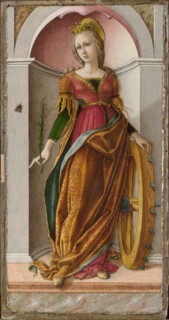It takes about ten minutes to walk from Birmingham New Street Station to the Ikon Gallery, which occupies one of the few Victorian buildings to have survived the redevelopment of the city centre. Above the excellent café and a shop, the white walls of the first floor, where contemporary art is normally displayed, are at present devoted to Carlo Crivelli (until 29 May). Most of the paintings have been borrowed from the National Gallery but there are major loans from elsewhere, including an exquisite panel from the Victoria and Albert Museum and the central panel of a grand altarpiece now kept in the Vatican Museum.
Among the loans from the National Gallery is the Annunciation (1486), one of the best-loved Renaissance paintings in London, in which Crivelli exhibited his knowledge of linear perspective in the recession of bricks and ashlar and the foreshortened apertures of a distant dovecote, and demonstrated his familiarity with the revival of ancient Roman ornament in the gilded Corinthian capitals and the terracotta relief of putti. But the impossibly elongated fingers of his Madonnas here and elsewhere reveal an attachment to late Gothic ideals, and the pierced and crocketed frames surviving on some of his polyptychs are spectacular examples of Gothic architecture. Crivelli seems to belong to two worlds.
He was not alone, in the final decades of the 15th century, in often retaining gilded backgrounds, but he had no rivals in decorating the gold with sharply incised and minutely punched patterns. He was also unusually skilled in building up the gesso ground of his panels into low relief, using the technique of ‘piping’ which is now only employed for embellishing the icing on a cake. He chose patterns that were difficult to render with the bladder and quill he must have used, giving the Virgin in the V&A’s panel a robe embroidered with long-beaked, long-tailed, long-winged birds, where the numerous fine raised lines often taper to a point. These are phoenixes which have migrated from Chinese textiles. Amanda Hilliam, in the excellent catalogue entry for this painting, likens the effect of this relief to that of the press-moulded silver foil which is a feature of many Byzantine icons, illustrating one from the 13th century in the cathedral of Fermo.* Such ‘Greek’ images, not all of them old, were found in many, perhaps most, homes of moderate affluence in Crivelli’s native Venice.
Gesso relief of this kind was probably first devised and certainly most often used for the representation of haloes, but in the Vatican altarpiece Crivelli superimposed a crown on a halo – relief on relief. He sometimes attempted high relief, giving some of his saints accessories carved in wood (a morse in one case and a pair of keys in another). More often there is a subtle interplay between real and apparent relief, so that, for example, at a distance of several feet the ruby on the Virgin’s forehead in the Vatican painting seems more substantial than the piece of coral hanging from the neck of the infant Christ, but on closer inspection it is the coral that is built up in the gesso whereas the ruby is simply painted. In other paintings by Crivelli, glass paste cabochons stand in for gemstones. Such tricks are more easily appreciated when his paintings are seen in the modern gallery and when the component panels of an altarpiece have been dismantled, save for one factor. Neither his altarpieces nor his small domestic panels are now illuminated by flickering tapers from below, and yet this sort of illumination was a precondition for the invention of such relief.
Apart from the haloes, which are mysteriously insubstantial, everything else in relief imitates a material that would shine when lit in this way, either jewels or, more commonly, an object made of metal which is gilded (or occasionally silvered) – the crown of the Queen of Heaven, the armour of Saint Michael, the keys of Saint Peter, encrusted ‘cloth of gold’. The coral may be something of an exception since it would only be shiny immediately after the infant removed it from his gums, but it was precious. So too was the blood of Christ, which is not represented in relief by Crivelli but was in an earlier painting by another artist from Venice, Marco Giambono. His astonishing painting Christ as the Man of Sorrows, now in the Metropolitan Museum of Art, is a reminder that Crivelli was not alone in such experiments in relief. Nor were they confined, in the late 15th century, to Ascoli Piceno and the neighbouring cities where Crivelli practised, for they are a conspicuous feature, for example, in the Adoration of the Kings (in the National Gallery) by Vincenzo Foppa, an artist who was active in Brescia at the same date.
Another aspect of Crivelli’s art may be associated with the trickery of his reliefs: his interest in trompe l’oeil more generally. He paints ledges in his foregrounds that appear to be inscribed and on top of which are placed fruits that apparently project into our space. Or he paints a swag of fruit across the top of a painting so that it casts a shadow on the sky painted there – prompting the title of this exhibition. No other artist employed such devices so insistently and they of course invite us to think about the nature of art and illusion. Does the trick of painting a fly on a painting serve also to remind us that the painting itself is a work of fiction, or does it merely increase our amazement at the artist’s skill? There are two painted flies in the exhibition, one on, the other in a picture. Do they elicit radically different reactions? How much more magical did these paintings seem to their original public? Were they fooled by the fruit as they may still be fooled by the fly? Above all, is naive amazement compatible with sophisticated delight? And what part did ‘cultic value’ and ‘sacral presence’ play in Crivelli’s trickery? The exhibition catalogue certainly helps us to ponder these questions, even if some of the authors can’t resist detecting in Crivelli’s work the exhibitionist ingenuities of modern academic discourse or the self-congratulatory witticisms of postmodernism.
Step back to review the work of the greatest European artists employing oil paint, and Crivelli, who worked in egg tempera, will not seem so eccentric in his preoccupation with deception. The device of the illusionistic inscription on frame or ledge was employed by Jan van Eyck before him and by Titian after him. The life-size fruit apparently projecting from a ledge is the subject of the great painting by Caravaggio in the Ambrosiana and was fundamental to still-life painting for the next three centuries. Which is not to deny that Crivelli was in many respects an exceptional artist or that working at some distance from the great centres of Venice and Florence enabled him to develop in an unusual way.
It is true that Crivelli, working in Le Marche, was little noticed by art historians until the 19th century, but by 1852, when two of his polyptychs were combined to form a giant altarpiece in the Roman Catholic chapel (there was also a Russian Orthodox chapel full of icons) in the Villa San Donato outside Florence, which belonged to Prince Anatole Demidoff, one of the richest men and one of the most avid art collectors in Europe, his work was highly fashionable. By 1877, the date on the gable of the Ikon Gallery, anyone keenly interested in Renaissance art was aware of his achievements, which were so well represented in the National Gallery, the fastest growing public collection in Europe. The full range of critical reaction to him around that date is admirably assembled in the catalogue by Stacey Sell. Crivelli was often viewed with some distaste but he was also admired and never ignored. More recently, two major 20th-century monographs have been devoted to him, so it is a surprise to find him described in an essay by Audrey Flack, reprinted in the catalogue, as ‘cast aside’ and rather amusing to read of his ‘discovery’ by her – not in a dark chapel in a rural church, nor in the basement store of a provincial museum, but hanging in the Renaissance section of the Met!
The illusion of rediscovery is perhaps a condition of enthusiasm: ardent lovers don’t care to dwell upon their predecessors. And enthusiasm is greatly to be welcomed since it has resulted in an exhibition devoted to an Old Master in a regional gallery associated with contemporary art – an exhibition, moreover, that was the initiative of the gallery’s director. This is a welcome change after a quarter of a century of intrusive interventions by contemporary artists in major collections of Old Masters or ancient art. It is a small exhibition but well judged as an introduction to the artist. The unobtrusive labels are supplemented by a free exhibition guide with succinct texts drawing attention to details and explaining puzzling features but not telling us what to think. There is no entrance charge and when I was there at half-term, the ‘us’ consisted of many visitors of all ages and diverse backgrounds.
Send Letters To:
The Editor
London Review of Books,
28 Little Russell Street
London, WC1A 2HN
letters@lrb.co.uk
Please include name, address, and a telephone number.



